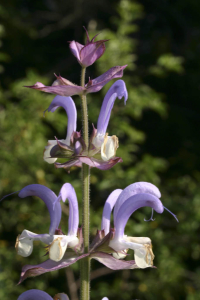 This month, we're studying 4 oils: Cinnamon (Cinnamomum zeylanicum), Clary sage (Salvia sclarea), Roman chamomile (Chamaemelum nobile) and German chamomile (Matricaria recutita). For this post, we'll concentrate on the two chamomiles.
This month, we're studying 4 oils: Cinnamon (Cinnamomum zeylanicum), Clary sage (Salvia sclarea), Roman chamomile (Chamaemelum nobile) and German chamomile (Matricaria recutita). For this post, we'll concentrate on the two chamomiles.
The flowers above are German Chamomile, Matricaria recutita, also called blue chamomile, Hungarian Chamomile, Chamomilla recutita, or simply matricaria. This is the type of chamomile typically used in herb teas.
According to Dr. Kurt Schnaubelt, "Blue chamomile is produced in many different countries and occurs in different colors ranging from a dark green to a vivid steel blue. The fragrance of genuine oils can be almost narcotic with hints of fresh fruit and cocoa." The blue tint comes from chamazulene, a by-product of the distillation process.
The American College of Healthcare Sciences describes chamomile as having "a warm, sweet, herbaceous, fruity aroma, but with not much tenacity. It blends well with benzoin, bergamot, citrus oils, clary sage, geranium, jasmine, lavender, neroli, oakmoss, patchouli, and rose. It is used extensively in cosmetics, detergents, perfume, soaps, and hair care products. It is said to impart a warm, fresh note with a natural depth."
Chamaemelum nobile's common names are Roman Chamomile, English chamomile, Chamomile romaine, or Camomile. Both chamomiles are said to contain the highest ester content of any essential oils. (Esters are renowned anti-spasmodics.) While both chamomiles are considered to be anti-inflammatory, the German chamomile is even more anti-inflammatory than its Roman cousin.
Use these essential oils for cramping, inflammation, skin irritation, wound healing, depression, aches and pains, irritability, nervousness, and insomnia.
If you happen to have either variety of chamomile flowers in your garden, try the following formula for aches and pains:
1 oz chamomile flowers
1 pint cold-pressed peanut oil
Mix together in a wide-mouth jar with a non-metallic lid. Leave in a warm but sunless spot for two weeks. Shake frequently, ensuring that all the flowers are beneath the surface of the oil. After two weeks, strain through a coffee filter or four layers of unbleached cheese cloth. Ensure no plant material is left in the oil as this can promote spoilage. Essential oil of chamomile can be added to the final product. Add rosemary oil (Rosmarinus officinalis) for extra pain relieving effect.
This formula can be modified to create an effective wound-healing blend by substituting 1/2 evening primrose oil and 1/2 olive oil for the peanut oil, and adding Immortele (Helichrysum italicum) and either variety of chamomile essential oil to the final product.
For conjunctivitis, add one drop of essential oil to 1/2 oz warm water and bathe the eye with sterile cotton balls. Be sure to use a fresh cotton ball for each eye and discard after use.



